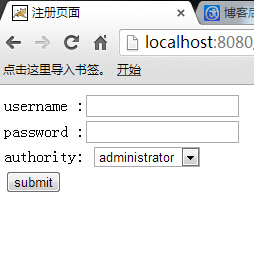定向转发和重定向实现 <select >下拉表单数据传送
定向转发的特点:
(1). 实行转发时浏览器上的网址不变 (如果你这点忽视了,那你就要接受我无尽的鄙视吧! 哇咔咔~~~)
(2). 实行转发时 : 只有一次请求。 不信,看这下面的图: (俗话说,没图说个jb)

(3). 定向转发的网址必须是本站点的网址. (因为它不消除,消除数据)
(4) 定向转发:以前的request中存放的变量不会失效,就像把两个页面拼到了一起。
实现的两个API:
RequestDispatcher rd
= request.getRequestDispatcher("Demo_1/Login.jsp"); rd.forward(request, response);
定向转发
关于定向转发实现selected选项功能:

上面这个控件的代码:
JSP代码:
<%@ page language="java" import="java.util.*" pageEncoding="UTF-8"%>
<%
String path = request.getContextPath();
String basePath = request.getScheme()+"://"+request.getServerName()+":"+request.getServerPort()+path+"/";
%> <!DOCTYPE HTML PUBLIC "-//W3C//DTD HTML 4.01 Transitional//EN">
<html>
<head>
<base href="<%=basePath%>">
<title>注册页面</title>
<meta http-equiv="pragma" content="no-cache">
<meta http-equiv="cache-control" content="no-cache">
<meta http-equiv="expires" content="0">
<meta http-equiv="keywords" content="keyword1,keyword2,keyword3">
<meta http-equiv="description" content="This is my page">
<!--
<link rel="stylesheet" type="text/css" href="styles.css">
-->
</head> <body>
<% String authority = (String) request.getAttribute("authority"); %>
<form action="LoginServlet" method="post" >
username :<input type="text" name="username" value="<%=null==request.getAttribute("username")?"":request.getAttribute("username")%>"><br>
password :<input type="password" name="password"><br> authority:
<select name="authority">
<option value="1"<%="1".equals(authority)?"selected":""%>>common user</option> <option value="2"<%="2".equals(authority)?"selected='selected'":""%>>administrator</option> </select><br> <input type="submit" value="submit"> </form>
</body>
</html>
效果图:

关于: 然后需要一个Servlet 类: (即纯java文件)
package Demo; import java.io.IOException;
import java.io.PrintWriter; import javax.servlet.RequestDispatcher;
import javax.servlet.ServletException;
import javax.servlet.http.HttpServlet;
import javax.servlet.http.HttpServletRequest;
import javax.servlet.http.HttpServletResponse;
import javax.servlet.http.HttpSession; public class LoginServlet extends HttpServlet { public void doGet(HttpServletRequest request, HttpServletResponse response)
throws ServletException, IOException {
String username = request.getParameter("username");
String password =request.getParameter("password");
String authority =request.getParameter("authority"); Login log = new Login();
HttpSession session = request.getSession();
if("1".equals(authority))
{
// 登录的是普通用户
if("zhangsan".equals(username) && "123".equals(password))
{
// 将用户的信息放置到Session当中 log.setUsername(username);
log.setAuthority(authority);
log.setPassword(password);
session.setAttribute("log", log);
}else { //定向转发
request.setAttribute("username",username);
request.setAttribute("password", password);
request.setAttribute("authority",authority);
RequestDispatcher rd = request.getRequestDispatcher("Demo_1/Login.jsp");
rd.forward(request, response);
}
}
else if("2".equals(authority)){
// 登录的是系统管理员
if("Tom".equals(username) && "456".equals(password))
{
log.setAuthority(authority);
log.setPassword(password);
log.setUsername(username);
session.setAttribute("log",log);
}
else { // 采取的是定向转发 request.setAttribute("username",username);
request.setAttribute("password", password);
request.setAttribute("authority",authority);
RequestDispatcher rd = request.getRequestDispatcher("Demo_1/Login.jsp");
rd.forward(request, response);
}
} else { request.setAttribute("username",username);
request.setAttribute("password", password);
request.setAttribute("authority",authority);
RequestDispatcher rd = request.getRequestDispatcher("Demo_1/Login.jsp");
rd.forward(request, response); } } public void doPost(HttpServletRequest request, HttpServletResponse response)
throws ServletException, IOException {
this.doGet(request, response);
}
}
一个 javabean文件:
package Demo;
//设置一个JavaBean 类
public class Login {
private String username ;
private String password ;
private String authority ;
public String getUsername() {
return username;
}
public void setUsername(String username) {
this.username = username;
}
public String getPassword() {
return password;
}
public void setPassword(String password) {
this.password = password;
}
public String getAuthority() {
return authority;
}
public void setAuthority(String authority) {
this.authority = authority;
}
}
重定向的特点:
(1)执行重定向时浏览器上的网址改变.
(2)重定向实际上产生了两次请求 (看下面的图)

(3)执行重定向时 的网址可以是任何网址。
调用的 API 函数:
response.sendRedirect("Demo_1/Login.jsp? username="+username+"&authority="+authority);
对于定向转发和重定向的实际执行情况,可以简单的慨括为:
对于重定向:
发送请求 -->服务器运行-->响应请求,返回给浏览器一个新的地址与响应码-->浏览器根据响应码,判定该响应为重定向,自动发送一个新的请求给服务器,请求地址为之前返回的地址-->服务器运行-->响应请求给浏览器
对于定向的转发:
发送请求 -->服务器运行-->进行请求的重新设置,例如通过request.setAttribute(name,value)-->根据转发的地址,获取该地址的网页-->响应请求给浏览器
特别需要注意的是:
重定向:以前的request中存放的变量全部失效,并进入一个新的request作用域。
转发:以前的request中存放的变量不会失效,就像把两个页面拼到了一起。
然后运用重定向实现<select> 下拉列表的代码:
对于JSP:
<%@ page language="java" import="java.util.*" pageEncoding="UTF-8"%>
<%
String path = request.getContextPath();
String basePath = request.getScheme()+"://"+request.getServerName()+":"+request.getServerPort()+path+"/";
%> <!DOCTYPE HTML PUBLIC "-//W3C//DTD HTML 4.01 Transitional//EN">
<html>
<head>
<base href="<%=basePath%>">
<title>注册页面</title>
<meta http-equiv="pragma" content="no-cache">
<meta http-equiv="cache-control" content="no-cache">
<meta http-equiv="expires" content="0">
<meta http-equiv="keywords" content="keyword1,keyword2,keyword3">
<meta http-equiv="description" content="This is my page">
<!--
<link rel="stylesheet" type="text/css" href="styles.css">
-->
</head> <body>
<%
String username = request.getParameter("username");
String authority = request.getParameter("authority");
%>
<form action="LoginServlet" method="post" >
username :<input type="text" name="username" <%= null == username ? "":username %> ><br>
password :<input type="password" name="password"><br> authority:
<select name="authority">
<option value="1" <%= "1" == authority ?"":"selected"%> >common user</option> <option value="2" <%= "2" == authority ?"":"selected"%> >administrator</option> </select><br> <input type="submit" value="submit"> </form>
</body>
</html>
对于Servlet类:
package Demo; import java.io.IOException;
import java.io.PrintWriter; import javax.servlet.RequestDispatcher;
import javax.servlet.ServletException;
import javax.servlet.http.HttpServlet;
import javax.servlet.http.HttpServletRequest;
import javax.servlet.http.HttpServletResponse;
import javax.servlet.http.HttpSession; public class LoginServlet extends HttpServlet { public void doGet(HttpServletRequest request, HttpServletResponse response)
throws ServletException, IOException {
String username = request.getParameter("username");
String password =request.getParameter("password");
String authority =request.getParameter("authority"); Login log = new Login();
HttpSession session = request.getSession();
if("1".equals(authority))
{
// 登录的是普通用户
if("zhangsan".equals(username) && "123".equals(password))
{
// 将用户的信息放置到Session当中 log.setUsername(username);
log.setAuthority(authority);
log.setPassword(password);
session.setAttribute("log", log);
}else {
//执行重定向函数
response.sendRedirect("Demo_1/Login.jsp? username="+username+"&authority="+authority);
}
}
else if("2".equals(authority)){
// 登录的是系统管理员
if("Tom".equals(username) && "456".equals(password))
{
log.setAuthority(authority);
log.setPassword(password);
log.setUsername(username);
session.setAttribute("log",log);
}
else {
// 采取的是重定向
response.sendRedirect("Demo_1/Login.jsp?username="+username+"&authority="+authority);
}
} else { // 采取的是重定向
response.sendRedirect("Demo_1/Login.jsp?username="+username+"&authority="+authority);
} } public void doPost(HttpServletRequest request, HttpServletResponse response)
throws ServletException, IOException {
this.doGet(request, response);
}
}
对于JavaBean类:
package Demo;
//设置一个JavaBean 类
public class Login {
private String username ;
private String password ;
private String authority ;
public String getUsername() {
return username;
}
public void setUsername(String username) {
this.username = username;
}
public String getPassword() {
return password;
}
public void setPassword(String password) {
this.password = password;
}
public String getAuthority() {
return authority;
}
public void setAuthority(String authority) {
this.authority = authority;
}
}
显示的效果:

定向转发和重定向实现 <select >下拉表单数据传送的更多相关文章
- css解决select下拉表单option高度的办法
css在给select下拉表单设置样式如边框时可以轻松搞定,而我们在不喜欢其默认的下拉箭头的样式时试图通过background:url(图片路径)来修改之,则往往会出现浏览器的兼容性问题,在网上查了好 ...
- ajax处理select下拉表单
$('#gameid').change(function() { var gameid = $(this).val(); if (this.value != '') { $.ajax({ url: ' ...
- s:select下拉框validation验证
S:select下拉框验证: <td colspan="5"> <s:select name="vo.typeVO.corp" list=&q ...
- 自定义样式的select下拉框深入探索
第一个版本: 首先实现自定义select下拉框应该具有的功能,我是选择将原来的select隐藏掉,自己在jquery代码中动态写进去<dl><dd><dt>这样的结 ...
- jquery取消选择select下拉框
有三个select下拉框一个大类,两个小类隐藏,需要在选择大类的时候,小类显示同时清除另外的小类选择的项这需求有点儿.......... 下面是三个select: <select name=&q ...
- jQuery插件:模拟select下拉菜单
没搞那么复杂,工作中,基本够用.. <!doctype html> <html> <head> <meta charset="utf-8" ...
- html select 下拉箭头隐藏
html select 下拉箭头隐藏 <!DOCTYPE html> <html> <head lang="en"> <meta char ...
- jquery选中将select下拉框中一项后赋值给text文本框
jquery选中将select下拉框中一项后赋值给text文本框,出现无法将第一个下拉框的value赋值给文本框 因为select默认选中第一项..在选择第一项时,便导致无法激发onchange事件. ...
- js如何获取select下拉框的value以及文本内容
select下拉框在项目开发中是经常用到的,特别是在联级菜单方面的应用更为广泛.但是,对于一些初学者来说,如何获取下拉框子节点option的value值和文本内容,还是有一点难度的.其他的就不说了,现 ...
随机推荐
- vsftp软链接ln遇到550错误
centos 6.3上新建了vsftp ,用于文件下载使用 ./var/ftp/pub可以匿名登陆下载 .如果想要上传则需要使用密码验证 . 登陆使用的账号是ftpclient ,路径在/home/f ...
- 2016ACM/ICPC亚洲区大连站-重现赛
题目链接:http://acm.hdu.edu.cn/search.php?field=problem&key=2016ACM%2FICPC%D1%C7%D6%DE%C7%F8%B4%F3%C ...
- [SAP ABAP开发技术总结]OK_CODE
声明:原创作品,转载时请注明文章来自SAP师太技术博客( 博/客/园www.cnblogs.com):www.cnblogs.com/jiangzhengjun,并以超链接形式标明文章原始出处,否则将 ...
- FLASH CC 2015 CANVAS (四)制作响应式设计(自适应)的项目
注意 此贴 为个人边“开荒”边写,所以不保证就是最佳做法,也难免有错误(如果发现我会更新文章)! 正式教程会在后续开始更新 相信你在看了(第二节)(第三节)之后已经能够满足绝大多数的互动需求了.那么也 ...
- nginx安装配置域名转发
1.安装pcre 1.[root@localhost home]# tar zxvf pcre-8.10.tar.gz //解压缩 2.[root@localhost home]# cd pcre-8 ...
- 在.bashrc文件中定义函数
在命令行上直接定义shell函数的明显缺点是当退出shell时,函数就消失了,对于复杂的函数来说,这可能会是个问题. 一个简单的方法就是每次启动新shell的时候都会自动加载所需要的函数. 最好的办法 ...
- iOS - Swift NSTimeZone 时区
前言 public class NSTimeZone : NSObject, NSCopying, NSSecureCoding NSTimeZone 表示时区信息. 1.NSTimeZone 时区的 ...
- 笔记本_thinkpad_e40
1. 0578A69 2.驱动下载 相关地址 XPhttp://think.lenovo.com.cn/support/driver/detail.aspx?docID=DR1253259153348 ...
- Python学习(14)模块一
目录 Python 模块 import语句 from ... import 语句 from ... import * 语句 定位模块 PYTHONPATH变量 命名空间和变量 dir()函数. glo ...
- 一次tomcat服务器被入侵解决办法
突然tomcat目录下莫名其妙的多了几个war文件,里面内容只有一个index.jsp,打开控制台发现多了几个应用,我可以确定不是我部署上去的,顺着应用访问竟然看到了
